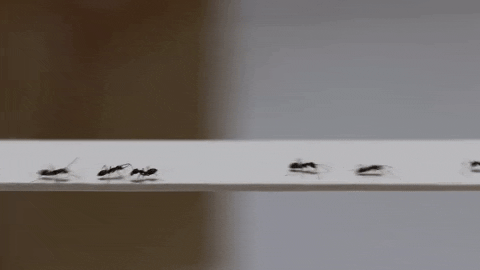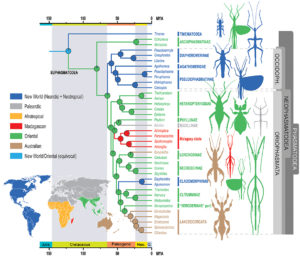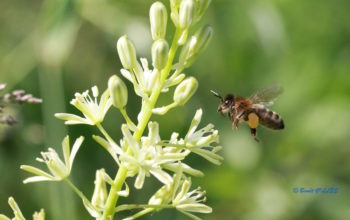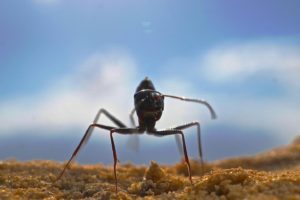By Laure-Anne Poissonnier
Insect societies have long been part of the human imagination. Ants appear, for example, in fables, tales, and science fiction novels. They are often attributed to human qualities: the ant is hardworking, selfless, and well organized. It is true that when one observes an ant colony, one is forced to marvel at the apparent order that reigns there.
Ants, like humans, need to go back and forth between their nests and their environment to bring back food. Some predatory species go back and forth individually, but most of them use tracks created by a deposit of pheromones, chemical compounds produced by specialized glands (e.g. the Dufour gland or in some species the venom gland) (illustrated below).
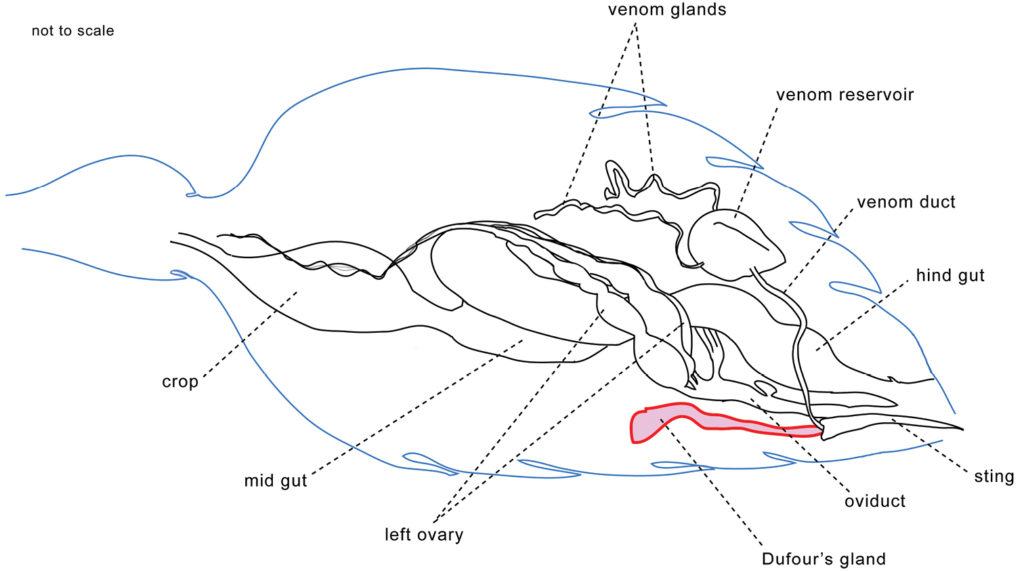
Ants chemically mark their way by depositing a small amount of pheromone on the ground. Because pheromones are volatile, the track must be maintained by new regular markings, otherwise the molecules evaporate and the track disappears. This system allows the ants to be effective and not to continue to engage on a track at the end of which the food would have been exhausted: the ants are motivated when they detect pheromones (using their antennae), but if they do not find nothing to eat they do not drop pheromones on their return, the trail will disappear and the other ants will not engage in it anymore.
Species that travel along the trails present one of the only cases in the animal world where individuals move along paths in two directions, towards food, or, back, back to the anthill. This two-way traffic is more complex than a simple common movement in the same direction, since ants have to rely on individuals coming in the opposite direction. Despite this, in some species, such as leaf-cutting ants (also known as mushroom ants) (video below), wood ants (Formica rufa) or legionnaires’ ants (generic name for species belonging to the subfamilies of Ecitoninae, Aenictinae and Dorylinae), the circulation can be very high, reaching more than hundreds of ants per minute. The comparison between our roads and the trails of the ants is striking: despite strict traffic rules, human trafficking seems more chaotic.
Who’s ever seen a traffic jam on an ant track? Would ants be able to succeed where generations of humans have had and still face difficulties?
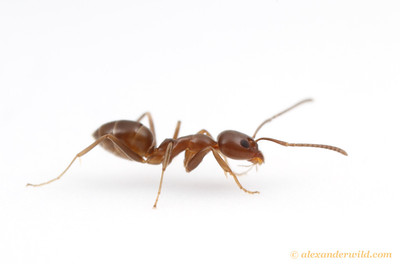
To get to the bottom of this, a team of researchers, of which I am a member, set out to precisely link the density of ants with the flow (how many ants cross the track per unit of time) along a forage track. The experiments were carried out at the Centre for Research on Animal Cognition (Paul Sabatier University, Toulouse). This centre is an international research centre for social insects (from the cognitive abilities of bees, to the movement of ants and to the construction of nests in termites).
Our team is particularly interested in collective behaviour. We chose as a species the Argentine ant (Linepithema humile) (pictured above), an invasive species that has conquered the majority of the inhabited world. It forms super-colonies of millions of individuals (it is even considered the largest colony of live animals), making it a perfect model for our study, since they are very numerous and (we assume) very effective in their forage to have such great ecological success and to have supplanted many species of local ants.

We connected ants’ nests to a platform where sugar water was placed, and the ants being forced to cross a bridge to access the sugar water (illustration above) (photos of the experimental installation in footer). By varying both the size of the nests and the width of the bridges, the researchers managed to create a wide range of ant density (number of ants per unit area). As a rule, the flow increases with increasing density (more individuals), then, after a certain value, decreases (the individuals slow down one another), to form a sort of bell curve.
But in ants this effect is not found! Their flow is biphasic, with an increase then a plateau. Even at very high ant density, we have not succeeded in creating a reduction in the flow (= congestion), while there is indeed a positive relationship between the density and the number of contacts between the ants.
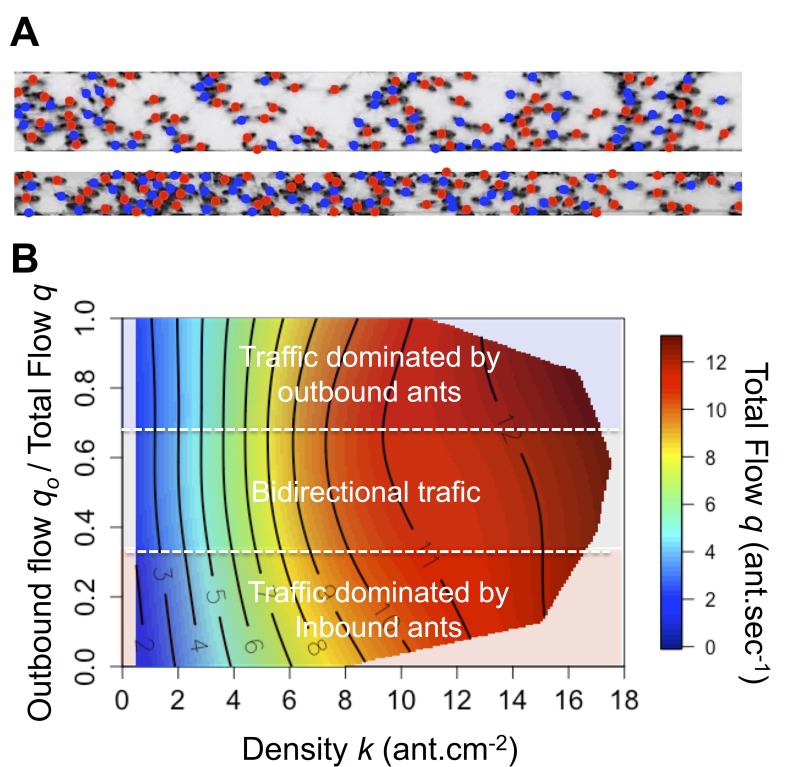
This is due to a number of factors. Ants, unlike cars or pedestrians, are not bothered by collisions, their exoskeletons protecting them from shocks. This allows them to waste less time avoiding each other, unlike a car, and they can regain their maximum speed very quickly (there is no time wasted accelerating). This allows them to maintain normal travel times up to densities of 8 ants per cm2, and then the density affects their movements.
To better understand the phenomenon, we looked at the individual behavior of these insects. Ants waste time with each contact with their congener: there is a linear relationship between the time it takes to cross the bridge and the number of contacts with other ants. These contacts can allow ants to collect information about the quality of food found by their congeners (olfactory traces on their bodies for example), or perhaps about the presence of a danger (predators).
Initially the ants accelerate with the increase in density, supposedly due to the increase in the concentration of pheromone on the track. At high density, ants have more contact with their congeners, but they spend less time interacting/communicating, and accelerate between contacts to make up for lost time. Finally, when the track is really black with ants, they simply stop engaging in it, until the track clears, which avoids total congestion.
Videos from the study
Ants move on a 20mm wide bridge
Ants move on a 5mm wide bridge
A previous study (Dussutour et al. 2004) showed that ants that have a choice between two paths quickly select one that will be used by the colony, because of the reinforcement of chemical marking: each ant that returns after finding food adds its own pheromones. But when the path gets too crowded, the ants start using the other path. This is done naturally, when ants trying to enter the congested path are pushed back by ants that arrive in the opposite direction on the other way.
This kind of process is called self-organization: the system organizes itself, without central control, each individual following simple rules.
The complex phenomena observed in ants (and other social insects), such as the architecture of their nests, or the regulation of traffic along the tracks, would therefore not result from central control (by their queen as the films often show) , but rather simple rules followed at the individual level, such as: “If the track is congested, I turn around or go down another path.”
In conclusion, the ants on their trail share a common goal, which is to bring food back to their colony, while humans on a road or sidewalk each have their own destination and personal goals, which could explain the best insect performance. The establishment and maintenance of the trails have a cost to the colony, and the rules of good exploitation of forage tracks had to be selected, which is not the case in humans.

